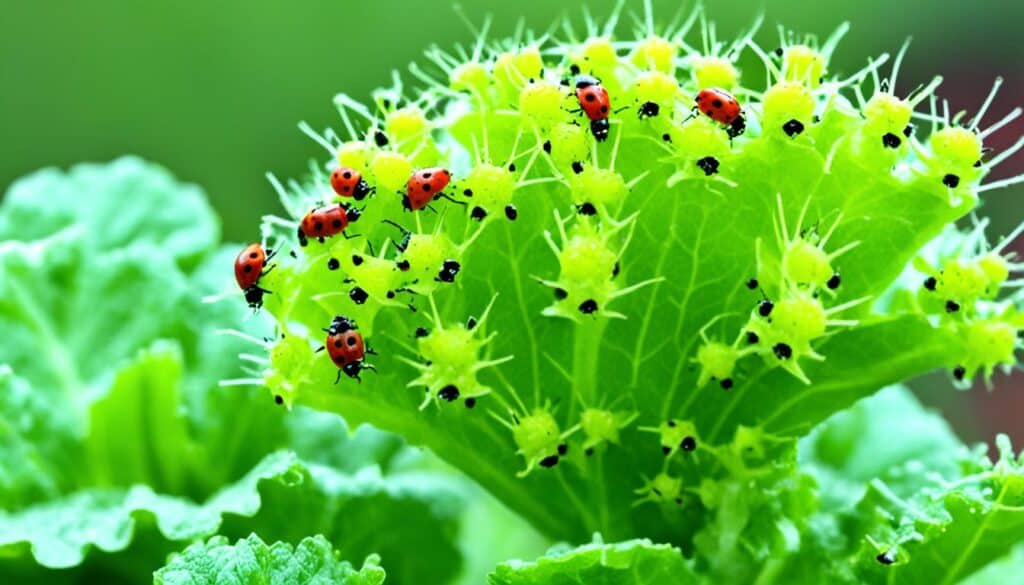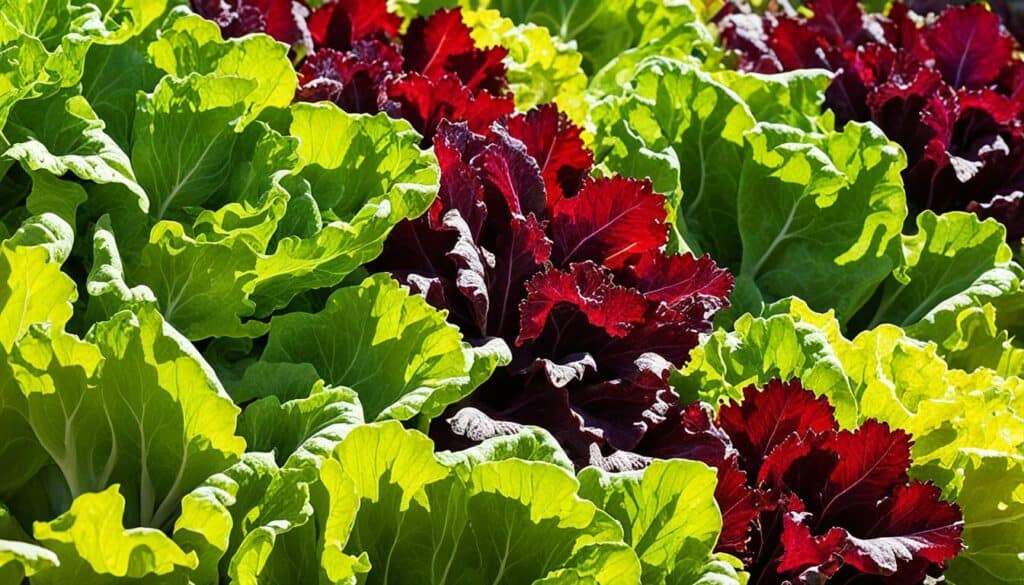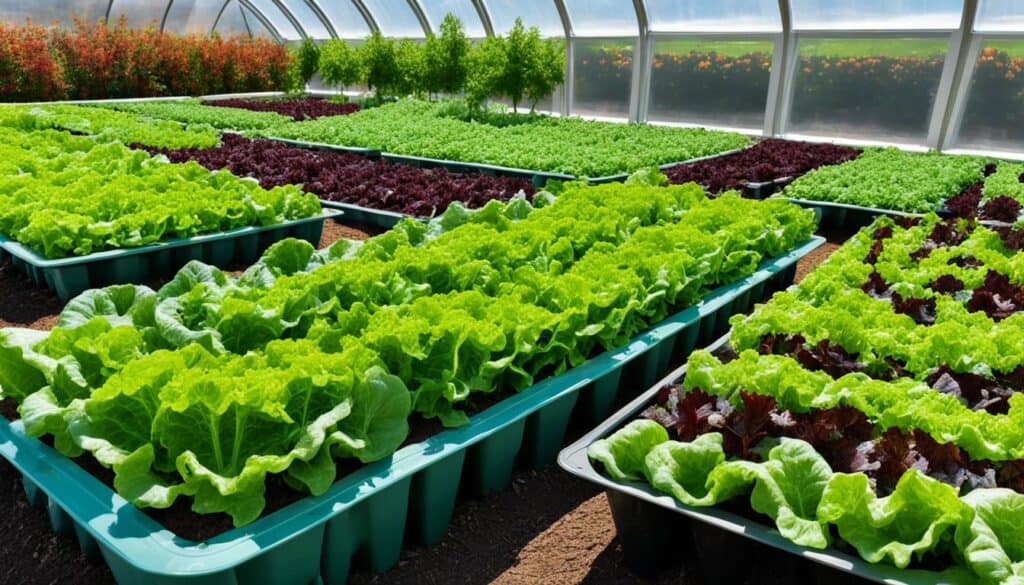Whether you have a spacious backyard or a small balcony, learning how to grow lettuce can provide you with a sustainable and delicious source of fresh greens. Not only is lettuce a versatile vegetable that can be enjoyed in salads, sandwiches, and wraps, but it is also packed with essential nutrients like vitamin K, vitamin A, and folate.
In this article, I will share easy tips and expert advice on growing lettuce successfully. From choosing the right varieties to planting and caring for your lettuce plants, you’ll discover everything you need to know to start your own lettuce garden. So let’s dig in and learn how to cultivate this leafy green in your own backyard!
Key Takeaways:
- Growing lettuce at home is a rewarding and sustainable way to enjoy fresh greens.
- Lettuce is rich in essential nutrients and can be used in various dishes.
- This article provides easy tips and expert advice on growing lettuce successfully.
- You’ll learn about choosing the right lettuce varieties and caring for your plants.
- Start your own lettuce garden and enjoy the delights of homegrown salads!
Planting Lettuce: Soil, Spacing, and Care
When it comes to planting lettuce, several factors need to be considered to ensure optimal growth and a bountiful harvest. From selecting the best soil to determining the right spacing and providing proper care, every step plays a crucial role in the success of your lettuce garden. Let’s explore the key aspects of lettuce planting in detail.
Choosing the Best Soil for Lettuce
Lettuce thrives in well-drained and fertile soil that provides essential nutrients for its growth. Ideally, the soil should have a pH level between 6.0 and 7.0, which is slightly acidic to neutral. This range creates the perfect environment for lettuce plants to absorb nutrients effectively and develop healthy roots.
To improve your soil’s fertility, consider adding organic matter such as compost. It enriches the soil with valuable nutrients and enhances its moisture-holding capacity, promoting robust lettuce growth. Incorporating compost also helps loosen compacted soil, allowing better root penetration and nutrient absorption.
Spacing Your Lettuce Plants
The amount of space you provide between lettuce plants depends on the variety you’re growing. Proper spacing ensures that each plant has enough room for its roots to grow and access water and nutrients. It also helps prevent overcrowding, reducing the risk of disease and promoting good airflow.
The recommended spacing for lettuce plants typically ranges from 6 to 18 inches, depending on the specific variety. Here’s a general guideline:
- Leaf lettuce: Space plants around 6-8 inches apart.
- Romaine and butterhead lettuce: Space plants approximately 10-12 inches apart.
- Iceberg lettuce: Space plants roughly 12-18 inches apart.
By following these spacing recommendations, you’ll ensure that your lettuce plants have ample room to grow, resulting in healthier and more robust crops.
Caring for Your Lettuce Plants
Proper care is essential for the overall health and productivity of your lettuce plants. Here are some essential care tips to keep in mind:
- Watering: Lettuce plants have shallow roots and require frequent watering to keep the soil consistently moist. Aim to water them regularly, especially during dry spells, to prevent soil dryness and dehydration.
- Mulching: Applying a layer of organic mulch around your lettuce plants can help conserve moisture, regulate soil temperature, and suppress weed growth. Use materials like straw, grass clippings, or shredded leaves as a natural mulch.
- Feeding: Fertilizing your lettuce plants with a water-soluble plant food can provide them with the necessary nutrients for healthy leaf production. Follow the instructions on the fertilizer packaging and apply it according to the recommended dosage for optimal results.
By implementing these care techniques, you’ll create an ideal environment for your lettuce plants to thrive, ensuring a plentiful harvest of crisp and flavorful leaves.
Growing Lettuce from Seeds: Timing and Planting
When it comes to growing lettuce from seeds, timing and proper planting techniques are crucial for success. Lettuce seeds should be planted during the mild weather of early spring or fall, as they prefer cooler temperatures for optimal growth.
To ensure successful germination, it is important to plant lettuce seeds in soil with the ideal temperature range of 45°F to 65°F. Direct sowing in prepared soil or module trays is recommended for convenient and effective cultivation.
When planting lettuce seeds, remember that they require light for germination. Therefore, they should only be planted 1/8 to 1/4 inch deep in the soil. Maintaining the proper depth ensures that the seeds receive adequate light to sprout and grow.
Depending on the type of lettuce you are growing, spacing between plants is essential to allow for healthy growth and leaf production. Loose-leaf lettuce can be planted approximately 4 inches apart, while romaine and butterhead lettuce varieties should be spaced approximately 8 inches apart.
For a continuous harvest throughout the growing season, it is advisable to sow additional lettuce seeds every 2 weeks. This staggered planting schedule ensures a fresh supply of lettuce leaves for salads or sandwiches.
| Lettuce Variety | Spacing |
|---|---|
| Loose-leaf lettuce | 4 inches apart |
| Romaine and Butterhead lettuce | 8 inches apart |
With these lettuce planting tips and cultivation methods, you can enjoy a bountiful harvest of fresh and delicious lettuce from your own garden. Remember to follow the recommended timing for planting and provide the appropriate spacing to support healthy growth. Happy lettuce gardening!
Indoor Lettuce Growing: Tips for Year-Round Harvest
Growing lettuce indoors offers a convenient way to enjoy a fresh supply of organic lettuce all year round. With the right techniques and conditions, you can create a thriving indoor garden that yields delicious lettuce leaves in just a few weeks. Here are some essential tips to help you successfully grow lettuce indoors:
1. Create the Perfect Environment
Lettuce needs ample sunlight to grow, so choose a sunny spot for your indoor garden. If you don’t have access to natural sunlight, you can use supplemental grow lights. These lights mimic the spectrum of sunlight and provide the necessary energy for lettuce growth.
2. Select the Right Containers
When growing lettuce indoors, opt for shallow containers with excellent drainage. This ensures that excess water can easily escape and prevents the roots from sitting in soggy soil. Consider using containers made specifically for hydroponic or indoor gardening.
3. Choose the Best Lettuce Varieties
Loose-leaf lettuce varieties, such as ‘Salad Bowl’ or ‘Red Sails’, are ideal for indoor cultivation. They have a faster growth rate and require less space compared to larger head lettuce varieties. These loose-leaf varieties also provide a continuous harvest, allowing you to pick leaves as needed and encourage new growth.
4. Provide Adequate Moisture
Consistent moisture is crucial for healthy lettuce growth. Keep the soil evenly moist, but avoid overwatering, as this can lead to root rot. Regularly check the moisture level by inserting your finger into the soil. If it feels dry, it’s time to water. Remember to use room-temperature water to prevent shocking the plant.
5. Implement Proper Fertilization
Indoor lettuce plants rely on nutrient-rich soil or a high-quality organic fertilizer. Before planting, prepare the soil by mixing in compost or an organic fertilizer specially formulated for vegetables. Additionally, you can use a water-soluble fertilizer to provide ongoing nutrition during the growing process.
6. Control Temperature and Humidity
Lettuce thrives in cooler temperatures, ideally between 60°F and 70°F (15°C-21°C). Avoid extreme temperature fluctuations and ensure good air circulation to prevent fungal diseases. Maintain a humidity level around 40% to 50% to prevent the leaves from drying out.
Harvesting lettuce from your indoor garden can begin in as little as three to four weeks, depending on the variety you choose. Start by removing outer leaves, leaving the central bud intact for continuous growth. You can harvest individual leaves as needed or cut the entire plant at the base for a larger harvest.
“Growing lettuce indoors is a fantastic way to have fresh, flavorful greens at your fingertips all year round. With the right conditions and a little care, you can enjoy the satisfying experience of growing your own organic lettuce, no matter the season.”
By following these lettuce gardening tips, you’ll be well on your way to a thriving indoor garden that supplies you with crisp and nutritious lettuce year-round. It’s a rewarding way to enhance your meals with fresh greens and add a touch of nature to your home.
Common Lettuce Pests and Troubleshooting
When growing lettuce, it’s important to be aware of common pests that can affect your plants. The most common pest that targets lettuce is the aphid. These tiny insects tend to hide on the undersides of leaves and can cause significant damage if not addressed promptly.
Aphid infestations can be managed using organic pest control methods:
- Insecticidal soap: A solution of insecticidal soap can be sprayed directly on the affected leaves to eliminate aphids. This method is safe for the environment and doesn’t harm beneficial insects.
- Neem oil: Neem oil is another organic option that can help control aphids. It acts as a natural insecticide and disrupts the aphids’ feeding and reproductive systems.
In addition to aphid infestations, lettuce can also face issues with bolting. Bolting is when the plant prematurely produces a seed stalk, usually triggered by high temperatures or changes in day length.
To prevent bolting and ensure the best growth for your lettuce:
- Provide shade: When growing lettuce in hot weather, providing shade can help reduce stress on the plants and prevent them from bolting.
- Consistent watering: Lettuce requires consistent moisture to grow well. Inconsistent watering can trigger bolting, so be sure to water the plants regularly.
Common Lettuce Pests and Troubleshooting
| Pest/Issue | Description | Troubleshooting |
|---|---|---|
| Aphids | Small insects that hide on the undersides of leaves and can cause damage. | Regular inspection and use of organic pest control methods such as insecticidal soap or neem oil. |
| Bolting | Premature production of a seed stalk due to high temperatures or changes in day length. | Provide shade and consistent watering to prevent bolting. |
Harvesting and Storing Lettuce: Tips for Freshness
When it comes to enjoying fresh and crisp lettuce from your garden, proper harvesting and storage techniques are essential. Here are some valuable lettuce harvesting tips that will help you maintain freshness and extend the shelf life of your lettuce:
Harvesting Lettuce
To harvest lettuce, you have two options:
- Option 1: Removing Outer Leaves – For leaf lettuce varieties, you can simply remove the outer leaves while leaving the central bud intact. This allows the plant to continue growing and producing more leaves. It’s best to start harvesting when the leaves are large enough and tender to taste. Remember, leaf lettuce can be enjoyed at any size.
- Option 2: Cutting the Entire Plant – Romaine and butterhead lettuce varieties should be harvested when they reach full size. Cut the entire plant at the base, approximately 1 inch above the soil level. This encourages new growth from the center of the plant.
Timing is Key
Lettuce tastes best when grown and harvested in cool weather, making spring and fall ideal seasons for harvesting. The crispness and flavor of lettuce can diminish when exposed to high temperatures, so it’s best to avoid harvesting during the hot summer months.
Storing Lettuce
Proper storage is crucial to maintain the freshness of your harvested lettuce. Follow these steps:
- Place your harvested lettuce in a loose plastic bag or container.
- Ensure the lettuce is dry before storing to prevent moisture buildup and potential rot.
- Place the bag or container in the refrigerator’s crisper drawer or a cool area, ideally set at temperatures between 32°F and 40°F.
- Store the lettuce for up to 10 days.
Pro tip: To keep your lettuce fresher for longer, consider investing in a salad spinner. The spinner helps remove excess moisture after washing, which can extend the shelf life of your lettuce.
| Lettuce Variety | Harvesting Time | Harvesting Technique |
|---|---|---|
| Leaf Lettuce | Ready to eat at any size | Remove outer leaves while leaving the central bud |
| Romaine Lettuce | When it reaches full size | Cut the entire plant at the base, leaving 1 inch above the soil level |
| Butterhead Lettuce | When it reaches full size | Cut the entire plant at the base, leaving 1 inch above the soil level |
By following these lettuce harvesting tips and storing your lettuce correctly, you can enjoy the flavors and benefits of fresh lettuce for longer periods. Now that you know how to harvest and store lettuce properly, you can confidently grow and enjoy your own delicious salads.
Choosing the Right Lettuce Varieties for Your Garden
When it comes to lettuce, there is a wide variety of options available, each offering its own unique flavors and textures. As a home gardener, selecting the right lettuce varieties can elevate your salad game and enhance the overall culinary experience. Consider the growing conditions and your preferences to choose the best lettuce for your garden.
Butterhead Lettuce
Butterhead lettuce varieties like ‘Buttercrunch’ and ‘Bibb’ are known for their tender leaves and mild, buttery flavors. These varieties form loose, compact heads that are easy to harvest. Butterhead lettuce is an excellent choice for salads and sandwiches, adding a soft and delicate texture to your dishes.
Romaine Lettuce
Romaine lettuce varieties, such as ‘Romaine’ and ‘Cos’, are known for their crispness and slightly bitter taste. These varieties feature elongated heads with sturdy, upright leaves. Romaine lettuce is ideal for Caesar salads and wraps, providing a satisfying crunch and refreshing flavor.
Loose-leaf Lettuce
Loose-leaf lettuce varieties, like ‘Red Oakleaf’ and ‘Green Salad Bowl’, are cherished for their vibrant colors and tender, delicate leaves. These varieties do not form heads but instead produce loose, open rosettes. Loose-leaf lettuce is perfect for mixed green salads, providing a diverse range of colors, textures, and flavors.
By incorporating a variety of lettuce types in your garden, you can enjoy a medley of tastes and textures in your salads and other dishes. Experiment with different lettuce varieties, and discover the ones that suit your preferences and growing conditions best.
Tips for Growing Lettuce All Year Round
With proper planning and cultivation techniques, it is possible to achieve year-round lettuce cultivation and enjoy a continuous lettuce harvest. To ensure a steady supply of fresh lettuce, consider implementing the following strategies:
Succession Planting:
One effective method is succession planting, where new lettuce seeds are sown every few weeks. By staggering the planting, you can ensure a continuous harvest throughout the year. This technique allows you to maintain a steady supply of fresh lettuce without the risk of running out.
Protective Measures:
Creating favorable growing conditions is crucial for year-round lettuce cultivation. Extreme temperatures can pose a threat to lettuce plants, but using cold frames or row covers can offer protection. These structures act as shields against harsh weather conditions, allowing lettuce to thrive even in challenging environments.
Indoor Cultivation:
If you have limited outdoor space or want to extend the growing season, consider growing lettuce indoors. Indoor cultivation offers greater control over temperature and light conditions, ensuring optimal growth throughout the year. Utilize grow lights and controlled environments to provide the necessary light and temperature for successful indoor lettuce production.
| Advantages of Year-Round Lettuce Cultivation | Disadvantages of Year-Round Lettuce Cultivation |
|---|---|
| – Consistent supply of fresh lettuce – Reduced reliance on store-bought lettuce – Increased self-sufficiency in food production |
– Additional time and effort required for indoor cultivation – Initial investment in equipment for indoor growing – Limited space for outdoor cultivation in certain regions |
By implementing these tips and techniques, you can enjoy a continuous lettuce harvest throughout the year, providing yourself and your family with fresh, homegrown lettuce whenever you need it.
Conclusion
Growing lettuce at home can be a rewarding and satisfying experience. From in-ground gardens to raised beds and even indoor settings, lettuce plants can thrive in various growing conditions. By providing the right soil, spacing, and care, you can ensure a successful lettuce harvest.
By following proper planting and harvesting techniques, as well as troubleshooting common issues like pests and bolting, home gardeners can enjoy a steady supply of fresh lettuce throughout the year. Whether you prefer crisp romaine, tender butterhead, or vibrant loose-leaf lettuce, there are numerous varieties to choose from to add variety and flavor to your homegrown salads.
So why not get started on your lettuce gardening adventure today? With just a little effort and attention, you can experience the delights of growing your own lettuce. Enjoy the satisfaction of harvesting greens from your own backyard and savor the freshness and goodness of homegrown lettuce in every bite. Happy lettuce gardening!










Leave a Reply